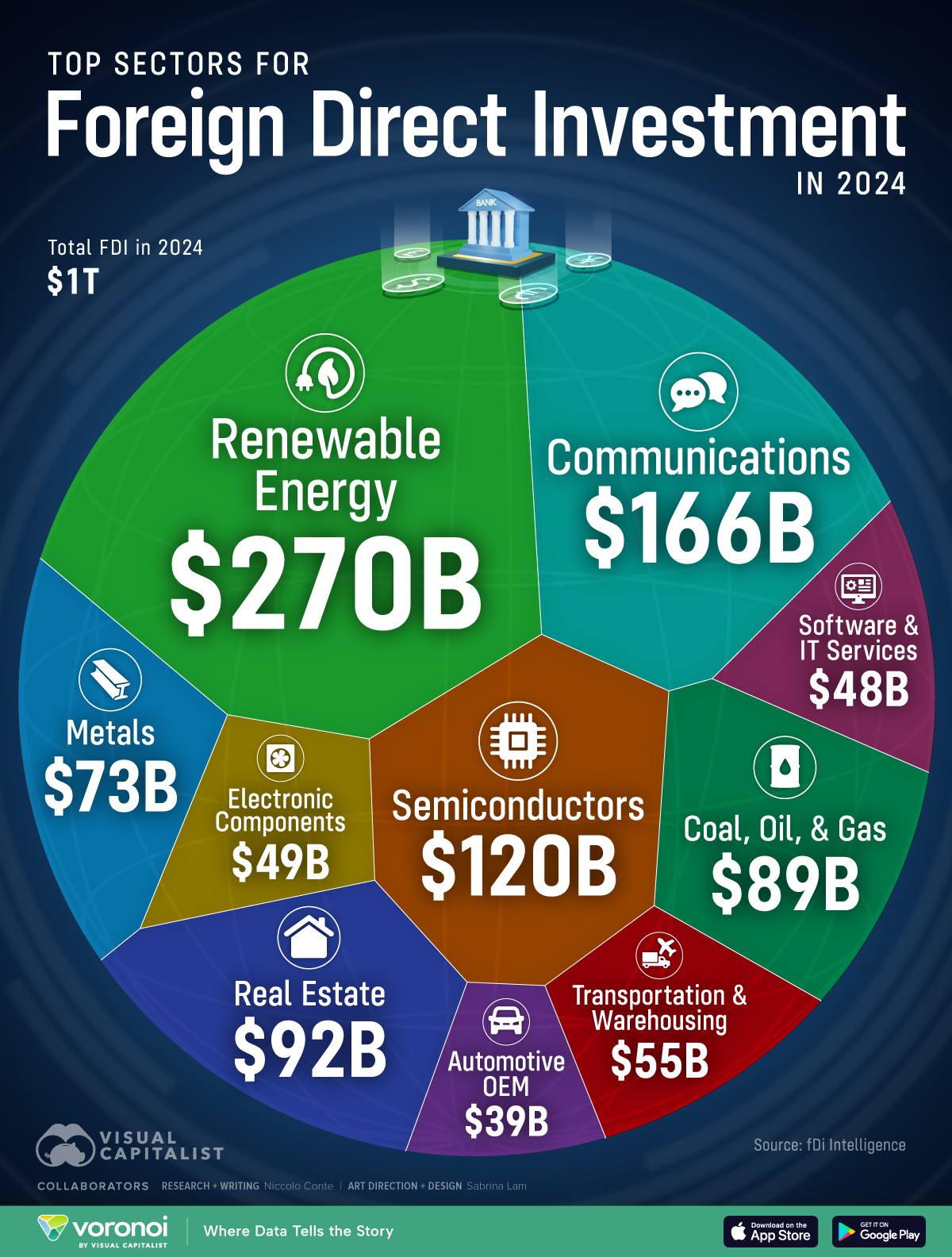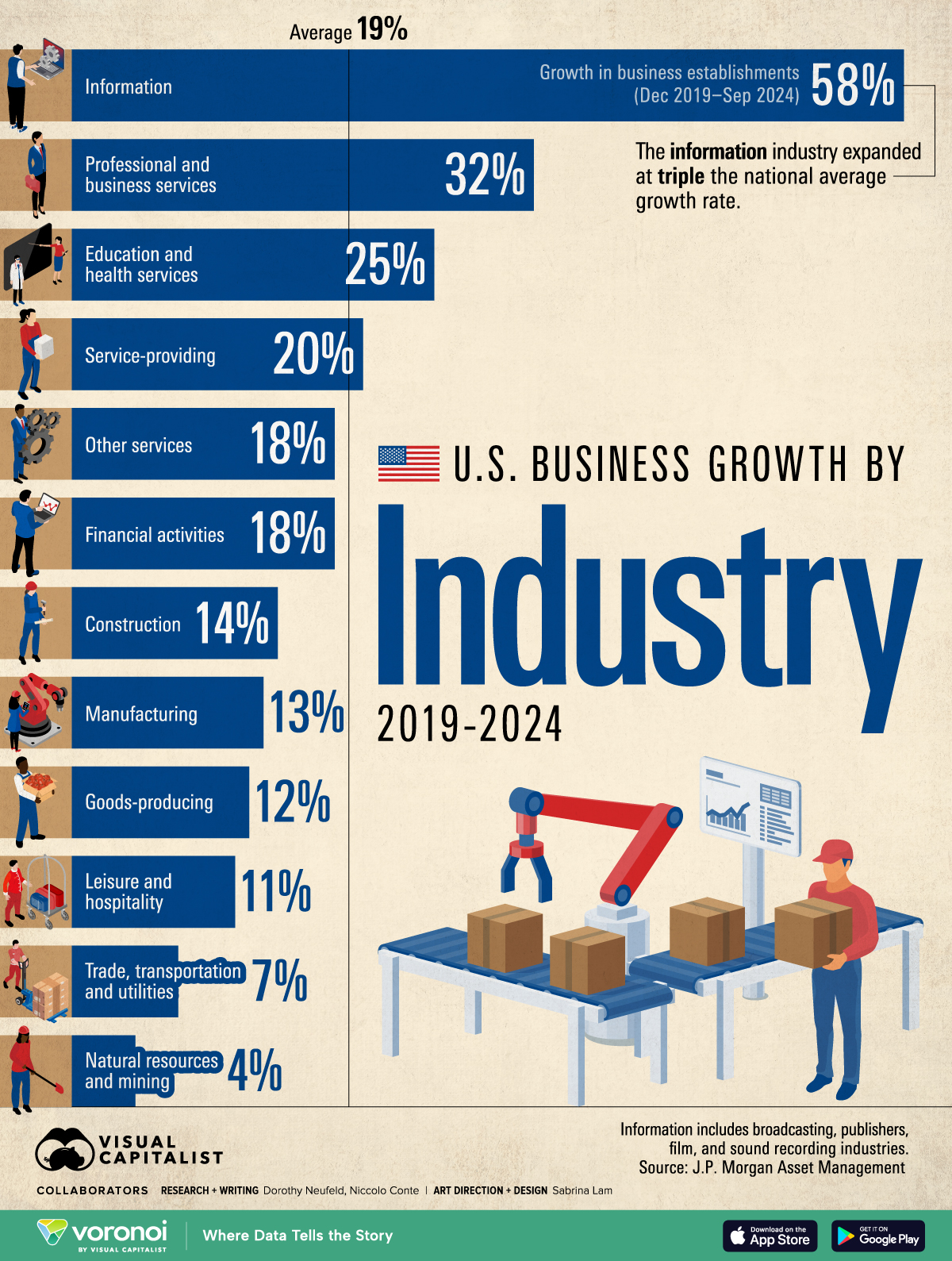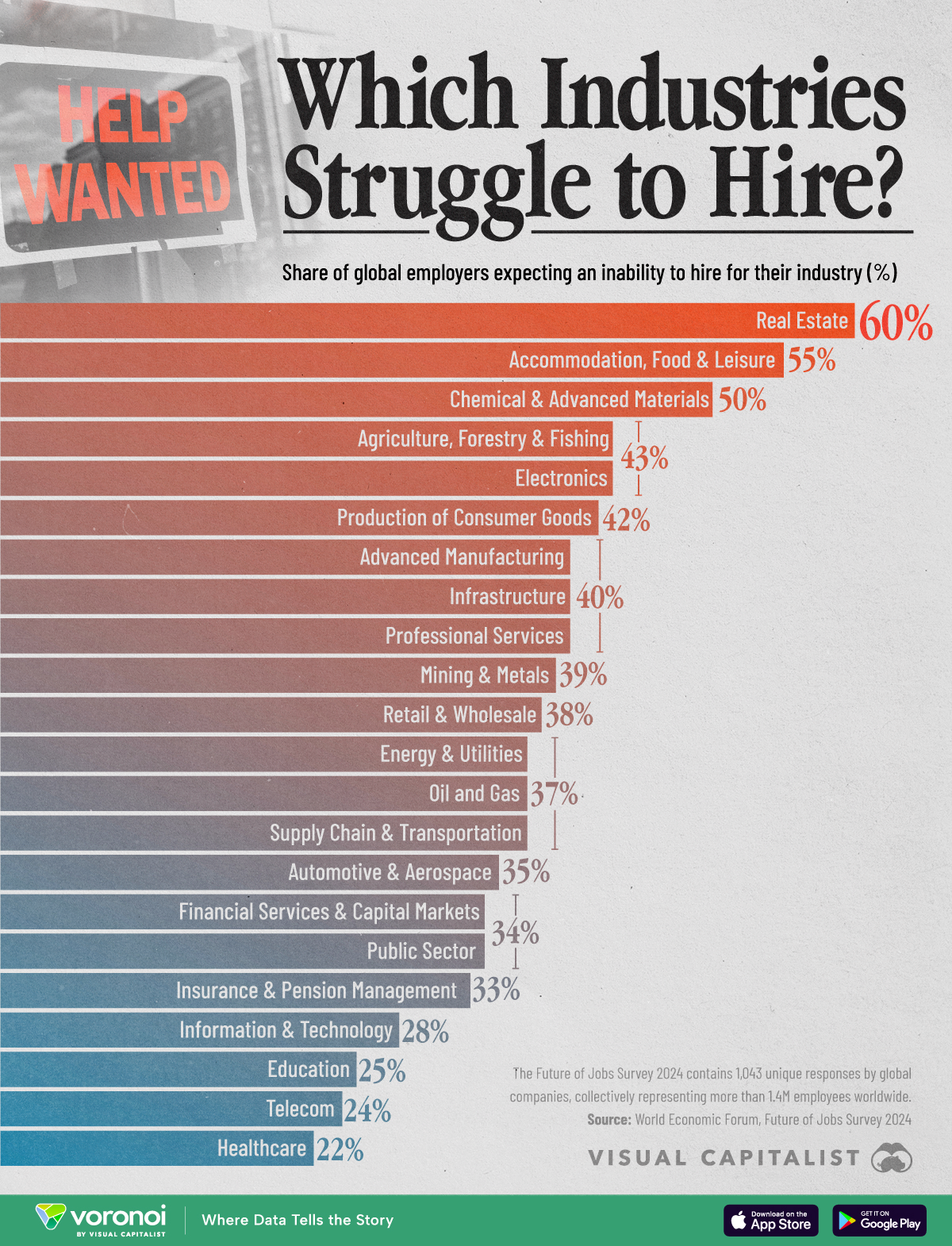The world’s stock markets are more intertwined and unpredictable than ever. As we step into 2025, the landscape is dominated by record highs, emerging uncertainties, and shifting regional dynamics. What forces are redrawing the map—and how should forward-looking investors respond?
Here is a look at global stock markets. Worldwide, they represented $127 trillion in value in 2024, with U.S. markets accounting for nearly half of that amount.
via visualcapitalist
Global Market Snapshot
For comparison, the global market has grown over 14% since 2023, when its value was approximately $111 trillion.
U.S. Dominance vs. Global Opportunity. While U.S. markets account for nearly half of the global value, it’s striking how far behind China and the EU lag. It is worth examining why ... and what may lie ahead.
Regional Comparisons
Let’s consider how other major regions are faring.
China’s stock market growth remains sluggish, held back by cautious consumers and the unpredictability of shifting government policies. The EU’s performance declined slightly in 2024, and faces headwinds from high interest rates and shifting energy dynamics. Meanwhile, emerging markets show wide variation—technology-driven countries outperform, while others lag due to policy or global uncertainty.
Here is a slightly deeper look at each.
China: Stimulus and Uncertainty. China’s government is attempting to stimulate its economy by reducing interest rates, repurchasing stocks, and increasing spending. That sounds positive, but people are still spending less, houses aren’t selling well, and the government often changes rules unexpectedly. Most regular Chinese don’t own stocks. For global investors, China is an intriguing yet risky market — one where outside forces frequently cause sudden shifts.
Europe: Value Amid Headwinds. Europe’s economy is diverse—its markets are a mix of banks, factories, and some technology. Wages are rising, and governments are spending. Sounds positive, but factors such as higher interest rates and global events continue to hinder progress. As a result, European stocks are generally cheaper than U.S. stocks, almost like a “value menu.” For investors, Europe remains a "safe harbor" steady option that can help balance out a portfolio, but don’t expect fireworks unless a few key factors break in their favor.
Emerging Markets: Technology’s Outliers. Meanwhile, emerging markets are more complex and susceptible to the influence of changing factors. Some countries, such as Taiwan and South Korea, are thriving thanks to strong technology growth. Others, such as Russia and Brazil, face challenges due to limited investment and instability. These markets are volatile, offering both high risk and potentially high reward..
Takeaways for Investors
The global market’s leadership is not set in stone; it is a rolling contest shaped by policy, innovation, and disruption. For investors and strategists, now is the time to reexamine assumptions, rebalance risks, and prepare for whatever comes next. In this era of constant change, adaptability—not allegiance—will be the source of enduring advantage.
Savvy investors spread their bets, recognizing that overconcentration in any single market can amplify both gains and risks.
For all the varied fears in Americans’ minds, U.S. dominance is driven not only by the strength of tech giants, but also by resilient consumer sectors and deep capital markets that set global standards.
As a result, America’s share of the global market increased approximately 7% over the past year, while China’s share has remained stable, and the EU’s share has declined slightly.
The good news for U.S investors is that global market capitalization is rising, and so is our share of it.
It’s easy to find reasons to be afraid or tentative ... but it’s just as easy to find reasons to take confident action.
Looking ahead, rising interest rates, geopolitical tensions, and new technology breakthroughs could all shift the balance of global market leadership. So could the growth of digital assets. Investors must consider what will happen next if these trends continue (or suddenly reverse).
Policy shifts in China or the EU could spark sudden capital flows, triggering domino effects that shape the next phase of market evolution.
Market leadership can change in an instant. In this climate, agility wins. Prepare, diversify, and stay alert—because in the world of investing, standing still is the biggest risk of all.
History has shown that the most prosperous periods are those that encourage creative destruction and reinvention.
You can't predict the future, but you can prepare for it.

 via
via 

Is Luck Something You Create?
This article explores the fine line between luck and skill in business, trading, and life. You’ll learn why success often comes from preparation and adaptability—not just fortunate timing—and discover actionable strategies for identifying and nurturing genuine skill in any competitive arena.
Picture a trader making millions in a raging bull market. Are they a genius, or just riding a wave of market luck? Now, picture yourself in their shoes. How do you know if tomorrow’s market crash will expose a lack of skill or confirm your edge?
Distinguishing luck from skill isn’t just a Wall Street problem—it’s the secret sauce behind enduring careers, resilient businesses, and long-term success stories everywhere.
Introduction: The Illusion of Streaks
Imagine achieving an unbroken streak of successes—so improbable that it seems almost magical. Was it raw talent, or was the universe simply smiling on you?
It’s human nature to believe it was your skill.
Now, imagine someone else achieved that streak. It is comforting to attribute some of that to luck.
What about a series of coin flips that land on heads twenty-five times in a row? Was that lucky, or have you discovered a new law of probability?
Easy, that was just luck.
This highlights a common trap known as confirmation bias: when things go well, we tend to attribute our success to our skill; when they don’t, we blame it on bad luck. Recognizing this bias is essential if we want to improve; otherwise, we risk falling into blind spots that prevent us from learning.
In 2016, I wrote an article about differentiating between luck and skill in trading. Those concepts seem even more relevant today as I spend more time talking with entrepreneurs and AI enthusiasts.
The Psychology of Success: Luck, Skill, and the Illusion of Mastery
Luck comes in many flavors. Most people prefer good luck to bad luck.
Focusing on the good, there are many lucky individuals in the business world. Perhaps they made a good decision at the right time – and are now on top of the world. Luck isn’t a bad thing — but building your entire strategy around it is a risky bet for lasting success. Why? Because you might get lucky once, but it’s unlikely you’ll get lucky every time.
As the saying goes, luck favors the prepared mind—especially those capable of discerning where skill ends and luck begins.
The Coin Flipping Contest: A Case Study in Probability
Suppose you followed the contest from beginning to end. As you approached the Championship Round, can you imagine the Finalists doing articles or interviews about how their mindfulness practice gives them an edge ... or, how the law of attraction was the secret.... or, how the power of prayer makes all the difference.
Occam’s Razor often applies: the best explanation is usually the simplest—someone had to win, and this time, it was luck, not mastery.
In any competition, someone will always win, but that doesn’t mean the winner is always the most skilled.
Luck isn’t just in trading or tech. Think of sports — sometimes, a championship hinges on a referee’s call or an unexpected bounce, not just one team’s superior skill. In music, countless talented musicians remain undiscovered, while some viral videos catapult their creators into overnight stardom. That’s the unpredictable role of luck at work in every field.
Warren Buffett once remarked: ‘It’s only when the tide goes out that you discover who’s been swimming naked.’ Success in a favorable market can look like skill — but only real skill endures when times get tough.
Likewise, just because a product or business generates revenue doesn’t necessarily prove it has a competitive edge. Every day, countless new AI-based apps are released. Many make money, some even become popular, but how many of them will still be here 5 years from now? Often, the businesses that are doing the best aren’t actually the ones providing the best service; they’re the ones with the best marketing & the most luck.
Lessons from Dot-Coms and Startups
Remember the dot-com era in the late ’90s? For every Amazon or Google that survived, hundreds like Pets.com and Webvan didn’t. Success often wasn’t about being the best; it was about timing, adaptability—and, sometimes, pure luck.
Focusing solely on current profitability can mean you might have a genuine edge—or you might have simply experienced a streak of good luck. If it isn’t just a matter of winning, how do we determine if we’re skillful? In trading, we refer to this as “Alpha” — the measure of a strategy’s returns attributable to genuine skill, rather than market trends or lucky breaks. Thus, the search for alpha is the search for clues that help identify systems with an edge (or at least an edge in certain market conditions).
Unfortunately, I cannot provide you with a single rule to follow in distinguishing between skill and luck. Still, it’s much easier to find the answer if you actively seek to differentiate between the two. Recognizing whether preparation or fortune played the bigger part requires conscious, continuous examination.
The reality is that most situations aren’t as purely luck-based as a coin-flipping contest. Many people appear lucky because they put themselves in the right situations and did the gritty work behind the scenes to prepare themselves for opportunities.
Do You Really Have an Edge? Validation Matters
That’s where skill (and the ability to filter out bad opportunities) comes in.
Internally, we’ve built validation protocols to help filter out systems that got lucky or those that cannot replicate their results on unseen data.
It is exciting as we solve more of the bits and pieces of this puzzle.
What we have learned is that one of the secrets to long-term success is (unsurprisingly) adaptability.
What that looks like for us is a library of systems ready to respond to any market condition — and a focus on improving our ability to select the systems that are “in-phase dynamically”. The secret isn’t predicting the future, but responding faster — and more reliably — to changing environments.
From a business perspective, this means being willing to adapt to and adopt new technologies without losing sight of a bigger ‘why,’ as we discussed in this article.
A Practical Example
When we first wrote about this, one of Capitalogix’s advisors wrote back to confirm their understanding of the coin-flipping analogy.
Well, that is correct. If we were developing coin-flipping agents, that would be as far as we could go. However, we are in luck because our trading “problem” has an extra dimension, which makes it possible to filter out some of the “lucky” trading systems.
Determining Which are the Best Systems.
There are several ways to determine whether a trading system has a persistent edge. For example, we can examine the market returns during the trading period and compare them with the trading results. This is significant because many systems have either a long or short bias. That means even if a system does not have an edge, it would be more likely to turn a profit when its bias aligns with the market. You can try to correct that bias using math and statistical magic to determine whether the system has a predictive edge. It Is a Lot Simpler Than It Sounds.
Imagine a system that picks trades based on a roulette spin. Instead of numbers or colors, the wheel is filled with “Go Long” and “Go Short” selections. As long as the choices are balanced, the system is random. But what if the roulette wheel had more opportunities for “long” selections than “short” selections?
This random system would appear to be “in-phase” whenever the market is in an uptrend. But does it have an edge?
One Way To Calculate Whether You Have An Edge.
Let’s say that you test a particular trading system on hourly bars of the S&P 500 Index from January 2000 until today.
According to the law of large numbers, in the case of the “roulette” system illustrated above, correcting for bias this way, the P&L of random systems would end up close to zero … while systems with real predictive power would be left with significant residual profits after the bias correction. While the math isn’t complicated, the process is still challenging because it requires substantial resources to crunch that many numbers for hundreds of thousands of Bots. Luckily, RAM, CPU cycles, and disk space continue to become cheaper and more powerful.
If your success can’t be replicated with new data, it may have been luck all along.
Conclusion: Tipping the Odds In Your Favor
Anyone can tally a win-loss column; far fewer can tell whether it was smarts, skill, or serendipity that made the difference. This is where rigorous analysis becomes invaluable.
Obviously, luck and skill affect every aspect of experience (from adopting technology, starting a business, transitioning from a product-based to a platform-based business model, or countless other scenarios).
In most situations, the secret is to determine what data is relevant to your industry, as well as what data you’re creating. Figure out how to analyze it. Figure out how to do that consistently, autonomously, and efficiently. Then ... test.
It’s not sexy, and it’s not complicated.
We live in a ready, fire, aim era. The speed of innovation is staggering, and the capital and energy required to create an app or start a business are at an all-time low. A bias for action is powerful.
Luck and a bias for action will take you further than most - but it still won’t take you far enough.
If you want to explore this topic further, consider reading “Fooled by Randomness” by Nassim Nicholas Taleb or “Thinking, Fast and Slow” by Daniel Kahneman. Both offer deeper insights into the psychology of luck and skill in markets and life.
Staying Honest
To conclude, I’ll leave you with a question...
If you’re reading this, you’ve almost certainly been lucky and skillful. Take a minute to list at least one thing you attribute to luck — and one to skill — in your career and life. With that in mind, what could you do differently in the future to tip the odds in your favor?
Try this, too: Next time you celebrate a big win, ask: Did I make my own luck, or did I simply wait for it to strike? In the end, the real edge belongs to those who learn to prepare, adapt — and still stay humble enough to know when fortune lent a hand.
Posted at 09:42 PM in Business, Current Affairs, Games, Ideas, Market Commentary, Science, Trading, Trading Tools | Permalink | Comments (0)
Reblog (0)